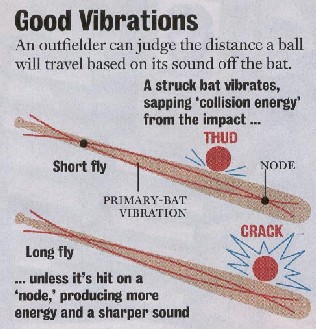To baseball fans, the sharp crack of a bat is one of the sweetest sounds of the game (at least if your team is up). But to an outfielder, that sound is a nightmare: it means head for the warning track. A thunk, though, tells an outfielder to race in to snare a fast-falling blooper. Since the ball's hang time is usually no more than five
|
 |
|
seconds, sound clues give the fielder a crucial jump on the ball long before he can see how far it's going: if a ball is hit at a center fielder playing 300 feet deep, one that will take five seconds to land 50 feet in front of him has an almost indentical trajectory in its first two seconds as one that will take 4.3 seconds to land 50 feet behind him and one that will take 4.6 seconds to drop into his glove if he stays put. "If an outfielder
waits until he can visually tell where the ball will land, that takes almost two seconds," says physicist Robert Adair of Yale University, who unveiled his study of bat sounds at a meeting this summer of the Acoustical Society of America. Two seconds can spell the difference between a putout and a hit.
What determines the sound? A wooden baseball bat is (trust us) not that different from a guitar string. When struck |
almost anywhere, it vibrates energetically, at a fundamental frequency of 170 cycles per second. "A lot of energy is lost in that vibration," says Adair, the National League's official physicist in the late 1980's. The energy-sapping vibration can hurt the hitter's hands. It also leaves less power for the bat to transfer to the ball, and it makes a sullen thunk - the sound of a ball that's staying in the park.
If the bat connects near its sweet spot, however, it vibrates very little, much as a tennis racket feels solid if you hit the ball on the racket's sweet spot. In the bat, that magic spot is called a node; hitting the ball there produces virtually no energy-sapping bat vibrations. The crack is the sound of air being expelled from between bat and ball. The ideal place to hit the ball is where three nodes cluster, in the fattest part of the bat. With a bat speed of 70mph, an 85mph pitch smacked near a node will sail 400 feet, good for a home run almost everywhere but straightaway center. A ball hit a mere five inches down the handle will be an easy 310-foot fly out.
|



